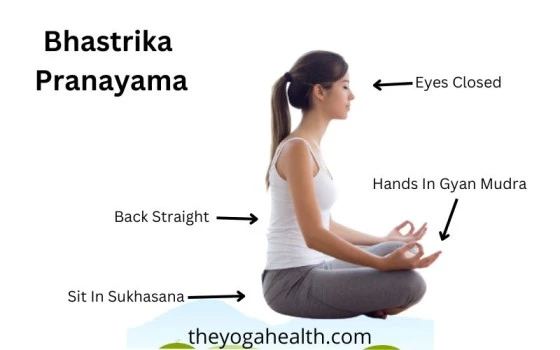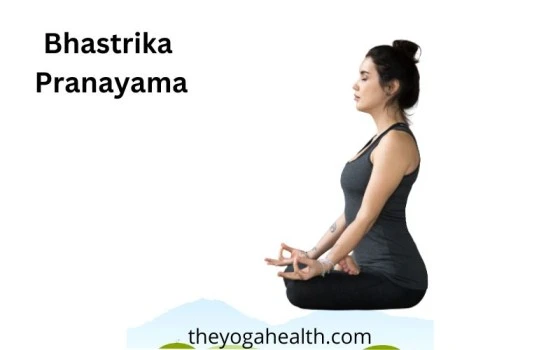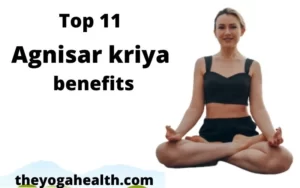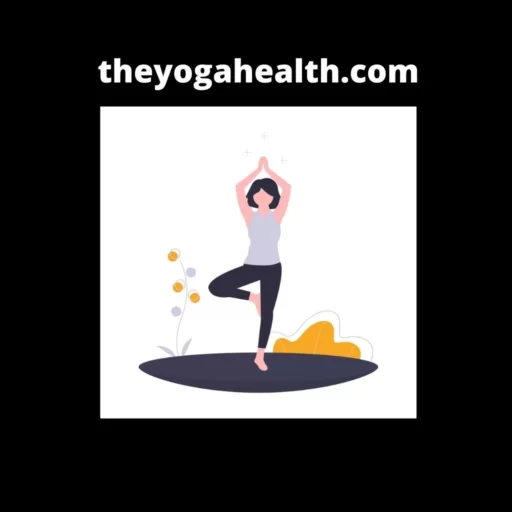Bhastrika Pranayama, which is also known as Bellows Breath, is an ancient yogic breathing method. This powerful breathing technique holds immense importance in the world of yoga and meditation.
Going deeper into the history and technique of Bhastrika Pranayama, in this article we will explore its relevance in modern times. We will also highlight the benefits and precautions associated with this powerful breathing practice.
Table of Contents
Bhastrika Pranayama
Bhastrika Pranayama is recognized as one of the most effective and dynamic practices for harmonizing the body and mind. Its rhythmic and forceful inhales and exhales contribute to its reputation.
Its natural and rejuvenating benefits make this pranayama technique easy-to-follow and renowned.
Inhaling and exhaling with continuous, rapid force is what Bhastrika Pranayama is all about. It is quiet like how a blacksmith relentlessly pumps the bellows.
Basic Details (Bellows Breath):
| Sanskrit Name | Bhastrika Pranayama |
| English Name | Bellows Breath |
| Difficulty Level | Beginner |
| Position | Sitting |
Historical Significance & Importance:
In India for thousands of years Pranayama has been practiced as an essential component of Yoga. Bhastrika Pranayama finds its roots in ancient yogic texts like the Hatha Yoga Pradipika and the Gheranda Samhita.
The word “Bhastrika” is derived from the Sanskrit term “bhastrika,” which translates to “bellows.” As we see a blacksmith pumps the bellows continuously to produce a steady flow of air to fuel the fire, this Pranayama do the same in our body. Bhastrika Pranayama involves vigorous, rapid breaths to stimulate the inner fire within the body.
This powerful practice can work wonders for balancing three doshas in our body. Additionally, it aids in purifying the chakras that promotes long-term healing effects.
The benefits of Bhastrika Pranayama are astounding. By practicing this Pranayama regularly, individuals with heart and brain issues can achieve miraculous results.
This Pranayama also helps to control blood pressure, improves the nervous system, and in reducing belly fat.
This useful pranayama can be excellent exercise for respiratory problems, such as asthma and allergies caused by pollution, smoking, infection, or lifestyle.
You May Also Like: Kapalabhati Pranayama
Important Points to Keep in Mind:
- Women during pregnancy and individuals with the issue of high blood pressure should avoid practicing Bhastrika Pranayama.
- Beginners should start with a slow pace and gradually increase the intensity.
- Those with lung, heart, or high blood pressure issues should perform the practice with caution and under expert guidance.
- This pranayama should not be performed for longer than two minutes in a single yoga practice during the summer seasons by the beginners.
- Before beginning the pranayama, make sure your nostrils are clean.
- If you feel nausea, dizziness, nervousness; or restlessness while performing this pranayama then you must stop immediately.
Asanas Associated with Bhastrika Pranayama:
This pranayama can be done by sitting in any of the above poses. If you able to sit in the Padmasana (Lotus Pose) you will get more benefits, but if you are new to the world of yoga and can not sit in Padmasana (Lotus Pose) then you can very well sit in the Sukhasana, which is very easy to perform.
Bhastrika Pranayama can be a powerful ally in your goal of naturally glowing skin, especially when it is practiced in the morning. The heat it generates within the body makes it particularly beneficial during the winter season.
A healthy respiratory function is the foundation of a vibrant life, and Bhastrika Pranayama can be helpful in addressing various health disorders.
Bhastrika Pranayama Steps
Performing Bhastrika Pranayama may appear simple, but mastering this technique requires practice and patience. Let’s get started:
1. Preparation:
Find a quiet, clean space to practice. Sit comfortably in Padmasana (Lotus Pose) or Sukhasana (Easy Pose). Ensure your spine is erect, and your shoulders and neck are relaxed. Place your hands on your knees, palms facing up, and gently touch the index finger and thumb together in Gyan Mudra.
2. Centering:
Close your eyes and take a few deep breaths, make yourself peaceful and ready for the Pranayama. Your mind should be free from all distractions and focus exclusively on your breath.
3. Inhale:
Begin Bhastrika Pranayama by inhaling deeply and forcefully through both nostrils. As you inhale, let your lungs expand fully, filling them with vital life force (Prana).
4. Exhale:
Without any pause, exhale forcefully through both nostrils in a single, powerful stroke. Imagine expelling all the impurities and negative energy from your body with each breath.
5. Rhythmic Breathing:
Maintain a continuous rhythm as you repeat the process of forceful inhalation and exhalation. The pace should be fast, resembling the pumping of a bellows. Preferably, 12 cycles per minute should be your aim and each cycle consisting of one inhale and one exhale.
6. Gradual Advancement:
When you regularly practice Bhastrika Pranayama and get more accustomed to it then you can start experimenting with the length of your inhalations and exhalations. Your ideal breathing pattern at first should be 2.5-second inhale to 2.5-second exhale ratio.
As you further advance in your practice you can eventually achieve a 1:2 ratio, where the exhalation will be twice as long as the inhale.
Awareness:
When you practice Bhastrika Pranayama, remain aware of your breath and the vibrations within your body. Feel the energy coursing through you with each breath, and embrace the vitality it brings.
Variations:
Variation – I
In this variation after sitting in the Sukhasana or Padmasana, from point 2 onwards. As you inhale you will raise your hands up and bring them closer to your head, opening your fingers.
During exhale you will close your hands in a fist and bring them down to our chest level. Inhale hands up fingers open, exhale hands down fingers closed. Do for two minutes to five minutes.
Variation – II
In the second variation after point 2, as you inhale you will raise (extend) your hands fully over your head, opening your fingers. As you exhale you will bring our hands down to your chest levels and closing your fingers in a fist.
Inhale hands up fully extended fingers open, exhale hands down fingers closed. Do for two minutes to five minutes as per your capacity.
Variation – III
In the third variation your hands will remain down on your knees, in Gyan Mudra and you will do your inhale and exhale as described in the above ‘Bhastrika Pranayama Steps’.
You May Also Like: Anulom Vilom Pranayama
Bhastrika Pranayama Benefits:
The benefits of Bhastrika Pranayama goes beyond its effects on respiratory health. It strengthens the lungs, enhances overall health, and improves blood circulation and nerve function.
1. Oxygenation:
Bhastrika Pranayama ensures that your body receives an abundance of oxygen. This oxygenation purifies the blood and enhances overall health.
2. Balancing Doshas:
According to Ayurveda, Bhastrika Pranayama can helps to balance the three doshas – Vata, Pitta, and Kapha. Balance of three doshas can lead to improved physical and mental health.
3. Nervous System:
This Pranayama practice stimulates and strengthens the nervous system that can result in better coordination and response to stress.
4. Blood Pressure:
Regular practice of Bhastrika Pranayama has been associated with controlling high blood pressure, promoting heart health.
5. Respiratory Health:
This pranayama clears the respiratory passages, making it an effective remedy for asthma, allergies, and respiratory infections.
6. Weight Management:
The vigorous breath work stimulates the metabolic rate and aids in weight management, particularly reducing belly fat.
7. Mental Clarity:
Bhastrika Pranayama boosts mental clarity, focus, and concentration, supporting overall cognitive function.
8. Kundalini Awakening:
This powerful pranayama is also believed to activate the Kundalini energy, which may lead to spiritual awakening and self-realization.
9. Inner Warmth:
Bhastrika Pranayama generates internal heat, making it especially beneficial during cold weather.
10. Purification of Nadis:
By cleansing the subtle energy channels in the body (Nadis), this pranayama helps in the free flow of Prana, enhancing vitality and well-being.

Precautions for Bhastrika Pranayama:
While Bhastrika Pranayama offers numerous benefits, it is essential to exercise caution and follow some precautions:
1. Avoid During Pregnancy:
Pregnant women should refrain from practicing this Pranayama, as the forceful breathing can lead to discomfort and exertion.
2. High Blood Pressure:
Individuals with high blood pressure should practice this pranayama under expert guidance and with a slow pace to avoid adverse effects.
3. Respiratory Ailments:
Those suffering from severe respiratory issues or heart problems should practice Bhastrika Pranayama gently and with care.
4. Summer Season:
During hot summer months, limit the practice of this Pranayama to two minutes to prevent overheating.
You May Also Like: Bhramari Pranayama
Conclusion:
Bhastrika Pranayama is a treasure of physical, mental, and spiritual benefits that has withstood the test of time. This dynamic breathing technique offers a powerful means of harnessing Prana, the life force, and channeling it towards holistic well-being.
When practiced with diligence, awareness, and respect for individual limitations, Bhastrika Pranayama can be a transformative force in your journey towards better health, mental clarity, and spiritual growth.
Include this magical breathing practice into your daily yoga routine, and witness its profound impact on your overall vitality and inner harmony.
FAQs:
Q1. What is Bhastrika Pranayama?
Bhastrika Pranayama is also known as Bellows Breath in English and is a essential part of yoga. It is an ancient yogic breathing technique involving rapid and forceful inhalations and exhalations.
The word “Bhastrika” comes from the Sanskrit language word for “bellows.” Bellows is a device used by blacksmiths to blow air into a fire to intensify its flames.
Just like bellows, this Pranayama increases the flow of vital energy (Prana) in the body that revitalize the mind and improve overall health.
Q2. What is Bhastrika Pranayama good for?
The benefits of this Pranayama are numerous and impressive. Regular practice can:
Boost the supply of oxygen to the body, promoting better respiratory function.
Enhance lung capacity and strengthen respiratory muscles.
Improve blood circulation, leading to increased vitality.
Reduce stress and anxiety levels, promoting mental clarity and relaxation.
Detoxify the body by expelling accumulated toxins.
Aid digestion and improve metabolism.
Stimulate the nervous system and enhance focus and concentration.
Improve overall stamina and physical endurance.
Q3. Who Should Avoid Bhastrika Pranayama?
While this Pranayama offers numerous benefits, it may not be suitable for everyone. People with the following conditions should avoid or modify the practice:
· Pregnant women
· Individuals with high blood pressure
· People suffering from heart-related ailments
· Those with respiratory disorders like asthma or chronic bronchitis
· Individuals with hernia
· Those who have recently undergone abdominal surgery
Those people having any medical concerns should consult a qualified yoga instructor or healthcare professional before attempting this Pranayama.
Q4. What is the best time to practice Bhastrika Pranayama?
Ideally, this Pranayama should be practiced on an empty stomach.
The best times for practice are early morning in both summers and winters and in the evening time in the winters only.
Always practice in a well-ventilated space and avoid any distractions.
Q5. How Long Bhastrika be done?
The duration of this Pranayama can vary based on your experience and physical condition.
For beginners, recommended time is 2 minutes of practice which can be gradually increased over time.
Intermediate practitioners can aim for 5 to 10 minutes.
Advanced practitioners can extend the practice up to 15 minutes or more.
Q6. Can Bhastrika Pranayama help with stress and anxiety?
Yes, this Pranayama can be highly effective in reducing stress and anxiety levels of the regular practitioners.
The deep inhale and exhale breathing pattern in this pranayama helps to induces a state of relaxation.
Q7. Can Bhastrika Pranayama improve digestion?
Absolutely! this Pranayama can aid digestion by massaging the abdominal organs and stimulating the digestive fire (Agni).
The increased blood flow to the digestive system enhances its efficiency that leads to better metabolism and nutrient absorption.
Q8. Can Bhastrika Pranayama improve mental focus and concentration?
Yes, this Pranayama can enhance mental focus and concentration.
The increased supply of oxygen to the brain during the practice helps improve cognitive function and clarity of thought.
By incorporating this Pranayama into your daily routine, you may experience better mental alertness and improved productivity.
Q9. Can pregnant women practice Bhastrika Pranayama?
This Pranayama is not recommended for pregnant women, as the forceful breathing may put unnecessary strain on the abdomen.
Pregnant women can benefit from other gentle breathing exercises and prenatal yoga practices.
In any case it is always advisable to consult a qualified prenatal yoga instructor before starting any new routine.
Q10. Can Bhastrika Pranayama improve respiratory health?
Yes, this Pranayama can significantly benefit respiratory health.
The deep and forceful inhalations and exhalations help clear the respiratory passages and improve lung capacity.
Regular practice can be beneficial for individuals with respiratory conditions like asthma and allergies.
Do share your experience of doing Bhastrika Pranayama, it will definitely help other readers as well and if You have any question or comments regarding this Pose, you can mention so in the comments section below.






